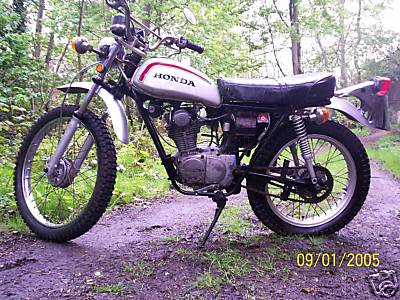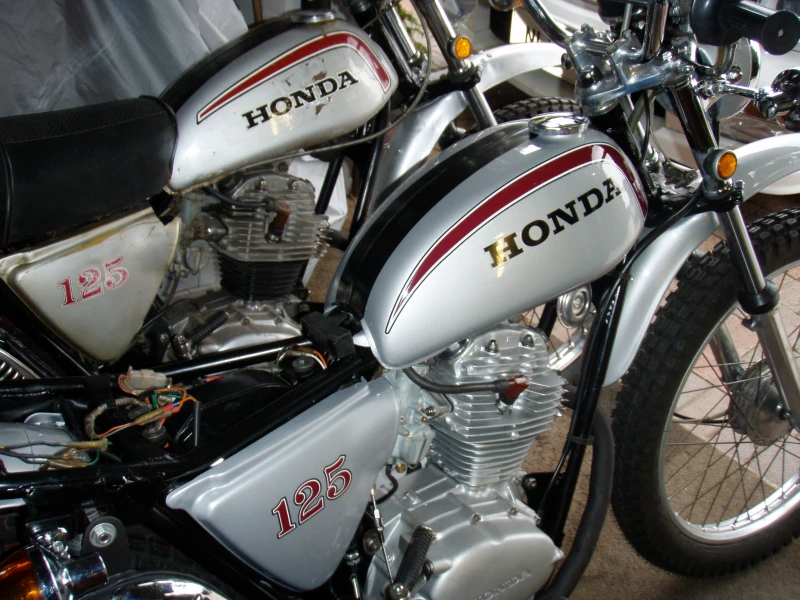Back around 1975, a friend of mine bought a Honda SL125 K1 brand new, and I still remember being very impressed when I first saw it. This was a time when most of us teenagers were riding early Jap commuter bikes or old BSA/Triumphs, so this stylish little bike, fresh out of the crate, was really quite something. Although having the same engine as the latest CB125s, the SL125 was in the forefront of the emerging trail-bike craze and its perky stance endeared itself to just about everyone. Quiet and reliable, it also began to change the perception that bikers were all ‘greasy rockers’, and in fact, ‘you could meet the nicest people on a Honda’.
I later went on to acquire various similar Honda trail bikes (TL125, XL125, XL185, XL500) and my first girlfriend also had an XL250 Motosport, but it would be many years before I finally got my first real SL125.
Fast-forwarding to 2008, I now had a 1340cc Harley-Davidson but still fancied something smaller to potter about on. After much deliberation, the idea of an SL125 came up and it wasn’t long before one was offered on eBay UK. It looked better than it eventually turned out to be, so I was lucky to be the only bidder and I got it for the starting price, rather than my highest bid!
![]()
Apparently the bike had been found in a storage container where it had languished for the past twenty years; even the tax disc still displayed on it read 1988! Although the bike wouldn’t start at the seller’s house, he reassured me it was usually OK, and I soon got it running once I returned home. It was then stripped to the frame to assess what needed doing.
The money pit opens up…
Since I had already decided that I was going to ‘definitely going to keep this one’ (a statement proved wrong so many times in the past) I was more inclined to fix things properly rather than simply bodge them up to stay on the road. This meant countless tired but essentially serviceable items such as tyres, sprockets etc were all replaced with expensive new parts. In addition, and perhaps predictably, the further I got into the bike, the more problems (sorry, ‘challenges’!) I discovered.
The forks had some non-standards gaiters fitted, and these concealed the rustiest most-pitted stanchions I had ever seen. It was clear these were well beyond simply cleaning up, so the only option was industrial hard-chroming by the specialist firm ‘Philpotts’. They did an excellent rapid job, but certainly not cheap, at around £150. The seat turned out to be entirely home-made, so that had to be replaced with a replica unit from the Far East, along with a NOS metal front mudguard (the latter a bargain at a mere £100…!) The rear shocks were non-standard and leaked oil, so they were thrown on the ever-growing scrap pile too. At least the tank looked good…until I discovered all the rust inside and decided it was cheaper to simply get a better replacement from the USA; even this needed specialist electrolytic cleaning.
And so the expenses continued on a global scale; a whole new pattern exhaust system ordered from New Zealand and various NOS components coming from the Far East, the Netherlands and the UK. All the chromed parts were sent off to be re-plated; a process that would actually take months, as paying less meant waiting until the company had nothing else to do!
At this point, another SL125 turned up on eBay. It was in a bad way, having been found in a cellar ‘up North’, but as it had some useful original parts, I thought it was worth ‘buying now’ at the asking price, high though that was.

Of course this turned out to be an ever worse ‘dog’ than the first one – doh! It had clearly been re-assembled from a pile of bits to look complete; for example, there were no head-bearings in it at all! The one redeeming factor was that it had an earlier and more valuable single-number registration plate, but using this now meant I had to start the build again with this rusty old frame, rather than utilising the better one I had been previously restoring.
The silver paintwork was all entrusted to an award-winning local firm that did do an excellent job, although they took months longer than they had originally told me, and still charged me a staggering £600.
As I was now surrounded by SL parts, I decided to recoup some money by first cherry-picking all the best bits, then building a second bike to sell from the leftovers. As the original bike’s engine ran, it made more sense to include this one and then recondition the second one, which was an unknown quantity anyway.

The ‘leftover’ bike (above) sold for about £300; not much, but it was no good to me, and simply getting in the way.
The other later engine was now dropped off at a local mechanic to be ‘checked out’…with a predictably depressing outcome. Apparently the previous owner had managed to run the engine out of oil, which had then destroyed most of the critical components inside. On this model, the camshaft runs directly in the aluminium of the head, and without oil, all the bearing surfaces had been completely wrecked. So now, a new head, new camshaft, new camchain, the cylinder needed a new piston and reboring, plus countless other parts, gaskets, labour etc – yet another massive bill, but at least that was the engine all sorted out now…or so I thought!
Snatching defeat from the jaws of victory…
Once the rebuilt engine was (eventually) ready for collection, I had finished the rolling chassis and the beautiful new paintwork was safely stored indoors, so the final assembly could now commence. This all went remarkably easily, which came as a pleasant surprise. The almost finished bike is seen here, along with the ‘leftover’ bike that I sold.

All that remained now was the official MoT test, and then I’d be out on the road…only about a year later than expected! However, the news from the MoT station came as a real shock. Although the bike had passed its test of roadworthiness, the mechanics said that there was definitely something seriously wrong with the rebuilt engine, as it was smoking and knocking badly. Obviously I was devastated, and I then had to return the bike to the original mechanic for him to rectify whatever was wrong.
This ended up taking several more months and involved stripping the whole engine twice. Eventually, throwing yet more good money after bad, parts were raided from another spare engine I had, the crank was reconditioned, bearings were changed and the engine finally ran as smoothly and quietly as Mr Honda had intended. Although the shop accepted liability and had done hours of work for free, there was still another big bill for other additional work that had now been done.
On top of that, there were now two large blisters that had arisen under the expensive paintwork on the petrol tank. Clearly, the paintshop had missed some tiny perforations in the metalwork and the petrol vapour was now lifting the paint. Once again, the tank would have to come off and be returned, also to be fixed under warranty…a job that would involve a complete strip and repaint, taking another six months!
So far, I’d had the bike two and a half years, spent an absolute fortune on it (including a year’s wasted tax, MoT and insurance) and had literally only ridden it up the road once. A very expensive ornament indeed, and seemingly a cursed one; well, it certainly was by me anyway…
If my collection ever has to be reduced for whatever reason, I know which bike will probably go first. However, after all the time and money I’ve spent on this thing, I might just hang on to it anyway, especially now it finally seems to be sorted out!
Hopefully I’ll take some decent photos of it somewhere scenic and then update the article soon.
UPDATE: And here they are! Taken last year (2012) at Wool Bridge in Dorset, a location made famous by author Thomas Hardy in his book ‘Tess of the D’urbervilles’. (Sadly, this bike has now been sold and is enjoying a new home in someone’s conservatory!)
But you can see (and hear) it running, via my video on YouTube here:

